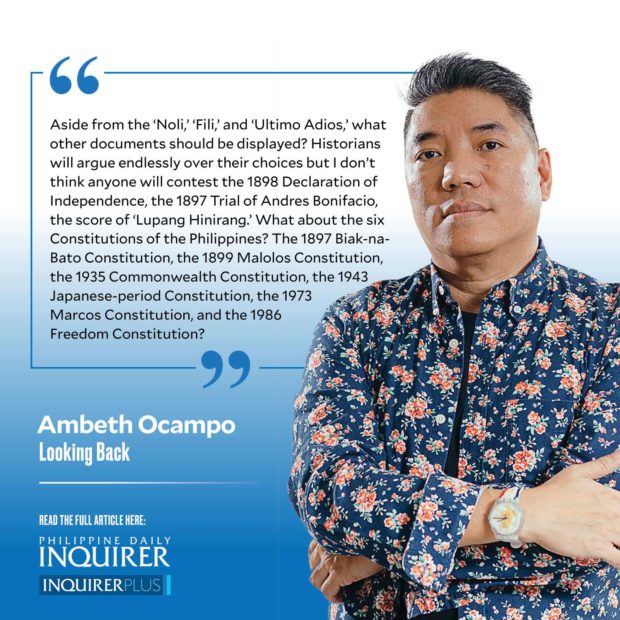Founding documents of the nation
Last week, I went to the National Library of the Philippines to view manuscripts, books, photographs, and ephemera brought out of the Filipiniana Rare Book Division for public viewing. Naturally, the stars of the show were the original manuscripts of Jose Rizal’s “Noli Me Tangere” and “El Filibusterismo” that, many schoolchildren are told, inspired the Philippine Revolution and led to the emergence of the Filipino nation. Unfortunately, I missed the original of the “Ultimo Adios” that was only displayed for a day. It was returned to the darkness of the vault to preserve it from fading. All light, even those from LED recommended by curators, cause deterioration to manuscripts. Also on display was the Declaration of Independence signed by the Founding Fathers in Kawit on June 12, 1898, and a prewar copy of the national anthem.
Being literally face to face with Philippine history reminded me of the way the US National Archives presents their founding documents in a grand building that resembles a Greek temple. On my first visit to Washington, I escaped from the organized city tour and made my way to the Archives, only to be disappointed because documents relating to the Philippines were stored in an off-site facility. However, the visit was not in vain because I experienced the thrill of seeing what are billed as the “Charters of Freedom.” The most significant historical documents are the Declaration of Independence of the United States, the US Constitution, and the Bill of Rights. All three documents were displayed under what looked like bulletproof glass. Everything was curated to impress, inside a marble hall whose scale made humans look and feel small, thus raising these historic documents to the level of holy relics. It is unusually cold and dark in the hall to prolong the life of the documents, and its effect on visitors was to make them shuffle reverently and quietly.
Shouldn’t we have a similar shrine to the founding documents of the Filipino nation? Can’t a selection of our most important historical documents be suitably displayed in one of the grand American-period public buildings in Manila like the Manila Post Office? Or maybe a dedicated hall in the Legislative, Finance, or Agriculture buildings that now form the National Museum complex? Our National Library building was considered “modern” in 1961. It is dated and worn out today.
Aside from the “Noli,” “Fili,” and “Ultimo Adios,” what other documents should be displayed? Historians will argue endlessly over their choices but I don’t think anyone will contest the 1898 Declaration of Independence, the 1897 Trial of Andres Bonifacio, the score of “Lupang Hinirang.” What about the six Constitutions of the Philippines? The 1897 Biak-na-Bato Constitution, the 1899 Malolos Constitution, the 1935 Commonwealth Constitution, the 1943 Japanese-period Constitution, the 1973 Marcos Constitution, and the 1986 Freedom Constitution? Properly curated and with informative wall texts and captions, these documents, normally kept from public view and veneration in a vault in the National Library building, can go beyond historical relevance to inspire a sense of nation among visitors.
Although I have seen and handled many of these rare Filipiniana materials before, I made an effort to see them again on display, if only to appreciate the awe these objects bring to the other visitors, many of who were seeing these for the first time. Theft may be one of the nightmares of librarians and archivists, but this should never impede scholarly access. Recent developments in library and archival conservation abroad is the use of clean bare hands to handle delicate materials. In the past, I used white cotton gloves for research. I switched to blue latex gloves since these worked on the touchscreens of smartphones and tablets used to take pictures. Gloves dull touch. Damage from oil on the hands is less of a problem than unintentional tearing of paper during use. A historian is not always an antiquarian. In my case, since I am allergic to book dust, I prefer a high-resolution digital copy rather than a fragile original. But I must admit I have a fetish for the smell of paper and the feel of paper on my fingertips. Allergies can be dulled by antihistamines.
Comments are welcome at aocampo@ateneo.edu





















